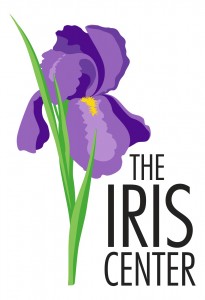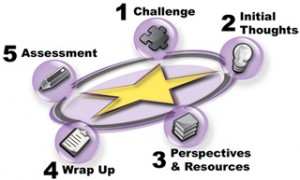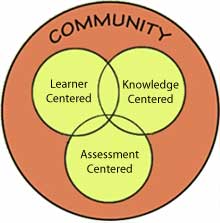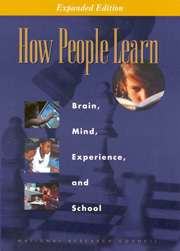How can faculty present important content to be learned in ways that improve student learning?
Page 1: Overview of the HPL Framework
 The IRIS Center believes:
The IRIS Center believes:
- A knowledge of rich, relevant, and well-researched content is required for learners to gain understanding and expertise.
- All curricula must be designed in accordance with a solid theory of learning.
- It is important to embed both content and theory into an operational model through which practitioners can create research-based learning environments to help learners become more successful.
With all of this in mind, the IRIS Center has cultivated access to many of the leading content experts in the field of special education. In addition, it has developed curricula under the guidance of the National Research Council’s report on learning science titled How people learn: Brain, mind, experience, and school (National Academy Press, 2001). To implement the instructional methods presented in this report, the IRIS Center has embedded its learning Modules in an operational model called STAR Legacy (Schwartz, Lin, Brophy, & Bransford, 1999).
How People Learn: Brain, Mind, Experience, and School (cover), by National Research Council, 2001, Washington, DC: National Academy Press. Copyright 2001 by National Academy Press. Reprinted with permission.
 In this module, we will explain and demonstrate both the How People Learn (HPL) theoretical framework and the STAR Legacy inquiry cycle. Though you may have some experience using one of the IRIS Center’s STAR Legacy-based Modules, you may not have learned about its theoretical underpinnings. Our desire is to offer you the opportunity to gain some measure of fluency with these ideas and technologies and, thus, to maximize learning when you use IRIS Modules. We are also convinced that the application of HPL and STAR Legacy, however flexibly, can improve teaching and learning in general. In fact, it has been said that “there is nothing as practical as a good theory or as theoretical as a good practice.” We believe HPL and STAR Legacy represent the truth of these words.
In this module, we will explain and demonstrate both the How People Learn (HPL) theoretical framework and the STAR Legacy inquiry cycle. Though you may have some experience using one of the IRIS Center’s STAR Legacy-based Modules, you may not have learned about its theoretical underpinnings. Our desire is to offer you the opportunity to gain some measure of fluency with these ideas and technologies and, thus, to maximize learning when you use IRIS Modules. We are also convinced that the application of HPL and STAR Legacy, however flexibly, can improve teaching and learning in general. In fact, it has been said that “there is nothing as practical as a good theory or as theoretical as a good practice.” We believe HPL and STAR Legacy represent the truth of these words.
Four Lenses that Focus Learning: Understanding the HPL Framework
 The diagram on the left illustrates what has come to be called the HPL framework. As you look at the diagram, you might find it helpful to think of the four components as four separate lenses, each focusing on a particular aspect of a complete, or balanced, learning environment. In this way, the HPL framework represents the goal of creating a learning environment where all of the important factors that influence how people learn are present and in balance for learning. This environment is defined as being learner centered, knowledge centered, assessment centered, and community centered. Watch the movie below for an overview of the HPL framework, and then we will examine it in more detail (time: 0:59).
The diagram on the left illustrates what has come to be called the HPL framework. As you look at the diagram, you might find it helpful to think of the four components as four separate lenses, each focusing on a particular aspect of a complete, or balanced, learning environment. In this way, the HPL framework represents the goal of creating a learning environment where all of the important factors that influence how people learn are present and in balance for learning. This environment is defined as being learner centered, knowledge centered, assessment centered, and community centered. Watch the movie below for an overview of the HPL framework, and then we will examine it in more detail (time: 0:59).
Transcript: Overview of the HPL Framework
The How People Learn framework is a way to organize thinking about the design of effective learning environments. It highlights four features that are important to this process, namely the degree to which learning environments are learner centered, knowledge centered, assessment centered, and community centered. Learner-centered involves taking into account students’ background knowledge, interests, and social and cultural values. Knowledge-centered involves providing rigorous content and helping students understand rather than simply memorize. Assessment-centered involves requiring high standards coupled with frequent opportunities for feedback, reflection, and revision, in order to enhance the quality of learning. Community-centered involves fostering norms where “learning of the highest order” is encouraged, people are respected and connected to a variety of resources, and it is acceptable to make mistakes.
